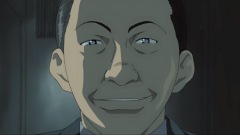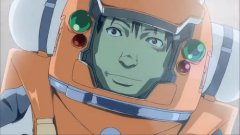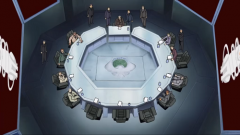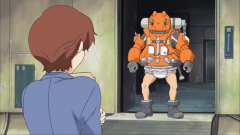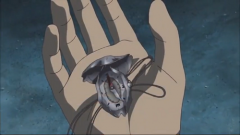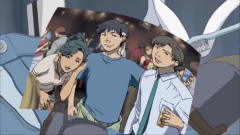If there is one thing I have lost watching seasonal anime, it is patience. Every week I expect something to happen, some kind of payoff, to make watching that week worth it. Luckily, Planetes as brought that back to me. Its depth of writing, characters, and general structure belay an anime of a different age. Before Moe and Sis-con took over the seasons. Back when a series was allowed to take things at its own pace, and actually finish its story rather than languishing in sequel hell. Of course, what else can you expect from the first work of Makoto Yukimura, the author of currently published Vinland Saga.
Lets jump in!
Art/Animation
As always, let’s start with Animation and Art style. Animation is easily Planetes weakest aspect, which considering there is nothing truly wrong with it, is a good sign. At worst Planetes‘ animation is minimal, with a good number of scenes being static images or just talking heads. This isn’t unusual nor is it a particularly black mark. More just a sign of its age. Being a more subdued story focused series, Planetes also lacks any major bombastic sequences. There are some very picturesque ones, which I will talk about when I get to Direction, but Planetes is a series that doesn’t really stand out when in motion. This isn’t because Planetes animation is bad however, it just knew what kind of series it was. Planetes didn’t need those kinds of sequences for its story, so it decided to be more subdued and consistent than bombastic, avoiding spikes and dips in quality.
Planetes art style however is much more impressive. Because the animation is largely simplistic, Planetes is able to take its time with its art. Giving great detail to every scene, making for some simply stunning images. From the shots in space of the Earth and Lunar landscapes, to the detail put into the technology. Planetes shoves detail into every corner it can find. Occasionally this can lead to a cluttered screen, but more often than not Planetes shows restraint and it all just works. Planetes artstyle lends itself very well to its focus on picturesque animation vs kinetic animation. As always, I must reference you to one of my favorite videos on this subject out there. I promise, last time. Probably.
Direction
As far as Direction goes, well this should be obvious. Planetes pairs its stunning artwork with brilliant direction, using inventive shots such as Hachi’s face reflected in multiple mirrors, or a ship floating away to reveal the sun. It’s use of mirrors, windows, light and sound all meld together perfectly. Planetes had so many scenes that left me in awe, I stopped counting about halfway through. I would wager every important character gets at least one of these shots. Establishing some core facit of their history or personality. Be it Ravi’s love for his family, Yuri’s acceptance of his wife or Fee contentment with the universe, all of them had some solo scene that was wallpaper worthy. I could probably gush about this, provide specific examples of each and every instance, for another few paragraphs. But that would defeat you watching the series, wouldn’t it? Just accept, it’s fantastic.
Story/Setting
Next up is Planetes story and setting. This is a mixed bag, as the episodic content can be very hit or miss depending on the week and focus. With all of the episodes tying into Planetes themes of Globalism and “No borders in space” philosophy, some viewers will no doubt tire of being preached to. If so however, there should still be something to enjoy, as a good number of the episodic stories are much more personal, focusing on the characters instead of the world at large. While some, such as Edle, miss the mark a bit, a majority of them are pretty good, with some being downright beautiful. For the larger story and final arc, while a slow burn at times, I think it ultimately accomplishes what it sets out to do. The writing is intelligent and never strays to far from the were the action is.
Planetes setting however is fantastically detailed and lovingly crafted. From the growing world governments in an increasingly expanding society to the scientific realism. From dependency theory to extreme environmentalism, Planetes has it all. In fact, on that second point, Planetes was so dedicated to this realism that the Japanese Space Agency (JAXA) served as technical consultants on the series. The US DVD release also featured interviews with two NASA scientists. Planetes portrayed all of this as realistically as possible, using dangers such as radiation poisoning and decompression sickness that real astronauts face to build up its world. Simply put, the details Planetes manages to fit in to every scene or discussion on space is nothing less than astounding. Even the premise itself, of collecting debris in space, is rooted in a very real and growing problem we have today.
Characters
Planetes characters are also fantastically made, most every named character getting some kind of arc or story. For such a large cast, this is impressive. In Technora alone Planetes boasts a 10+ cast, and that isn’t even including many of the side characters such as Nono or the ninjas. Planetes manages to give each and everyone of them, from Claire and Hakim, to Dolph and Ravi, good characterization and story beats unique to them. Some of the best episodes are focused on these characters and their stories. In fact Planetes made me tear up for the first time in a long time with Yuri’s character story, showing the strength of the writing. None of them are stereotypes, Planetes trying its best to go beyond simple caricatures.
It’s not perfect on this front though sadly. Some of the interactions just don’t feel right, such as the initial setup of Tanabe and Hachimaki’s relationship. Some of this disconnect is no doubt due to the English dubs, which were the best versions I could find. This gets rectified later on, as it no doubt knew the two had no chemistry in their initial forms. But it does make some episodes or stories in the latter half a little grating. Overall though, the characters and their stories are phenomenal and Planetes is worth watching almost for them alone.
Music/Sound Design
Finally, lets talk music and sound design. Planetes does a great job here as well, from the details of space to the music chosen for scenes. There are some tracks, such as a particular vocal, that plays over some of the more emotional scenes that I simply love. Planetes brilliantly selects the music for each scene and character. The sound design as I said is also fantastic. The series remembers to have minimal sound during the space scenes. Only really giving us the space suit coms and the hiss of air as they navigate the void. It’s these details that really suck a viewer in, and help get them in the same head space as the characters. Outside of space, the folly work is pretty much industry standard, which means its nothing to scoff at. But space is where, in every respect, Planetes shines.
Conclusion
Overall, Planetes is a damn good production. It is clearly aged, but like a fine wine, it has aged well. The series is from a different era where full stories and mature themes were more common. Before Moe and Isekai took over the medium. Yes, it has its flaws. Some of the middle section drags a bit, and this loses it a few points. But the final product, the way I feel about the series as a whole now that it is over? I feel immensely satisfied. I know that one day I will want to watch Planetes again. It won’t be tomorrow, it probably won’t be this year or the next. But I will remember the name, and if I ever see the manga in print, you can bet I am going to pick it up.
So long story short, watch Planetes. It won’t waste your time.

